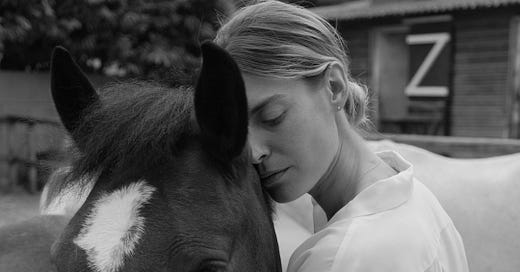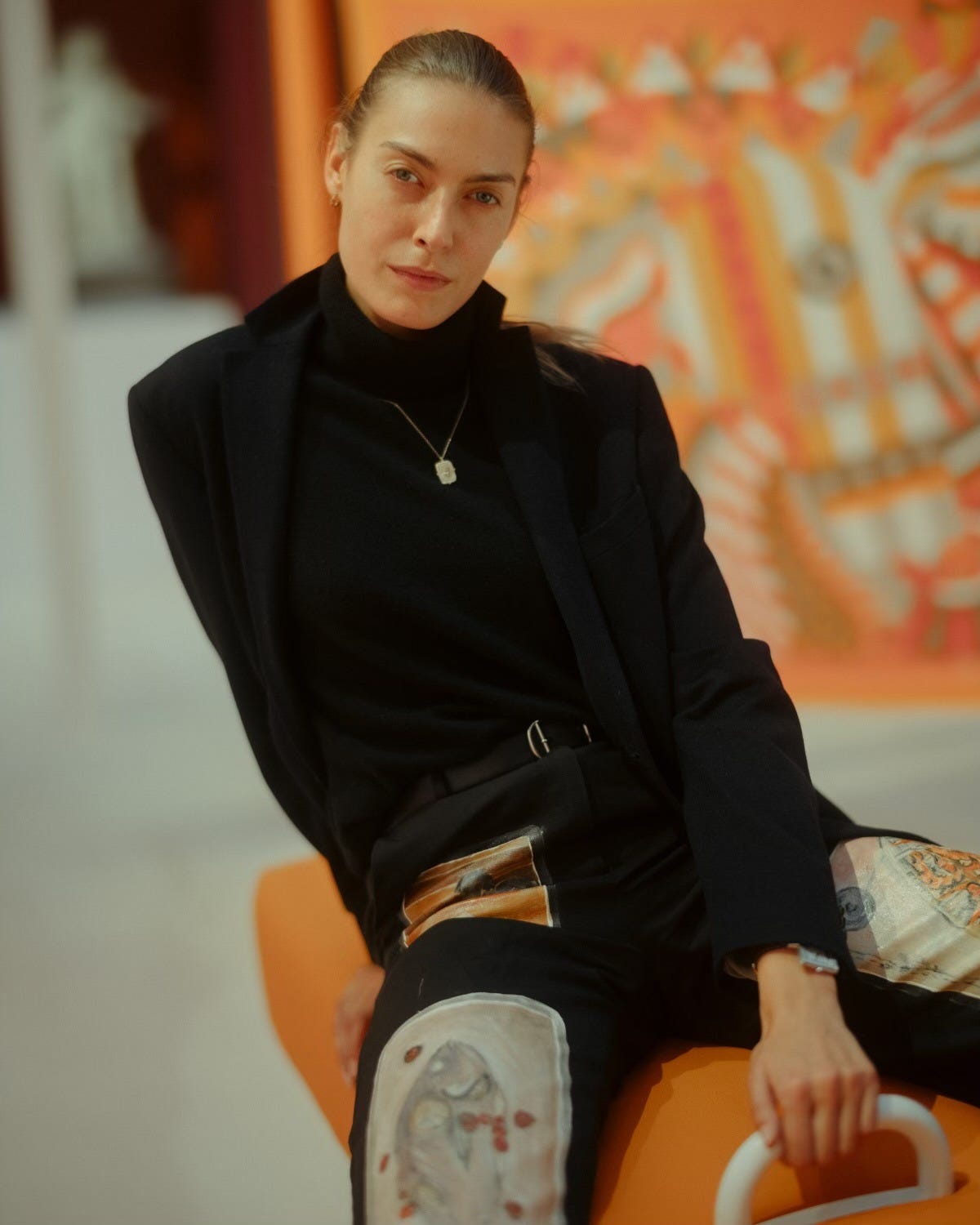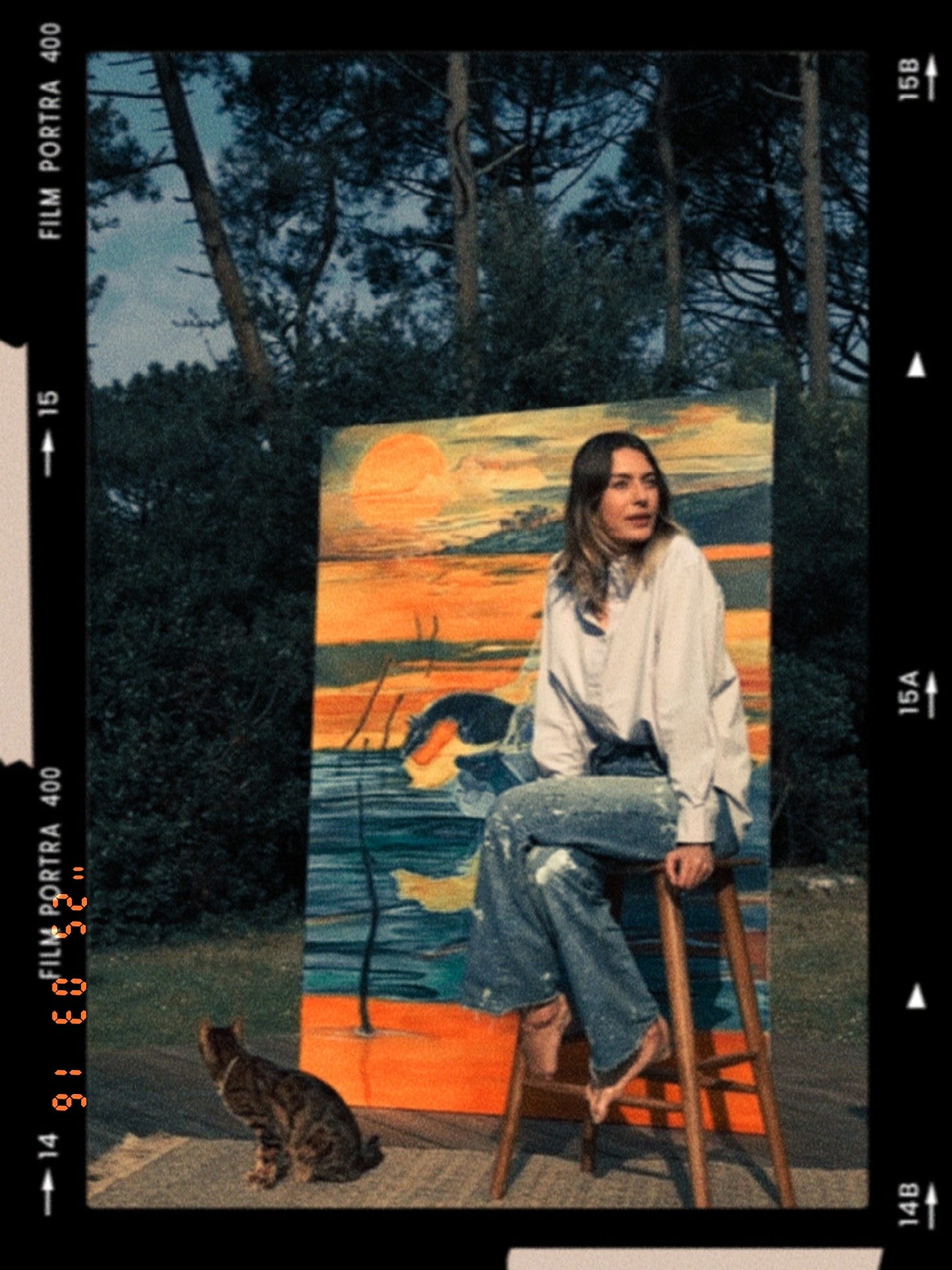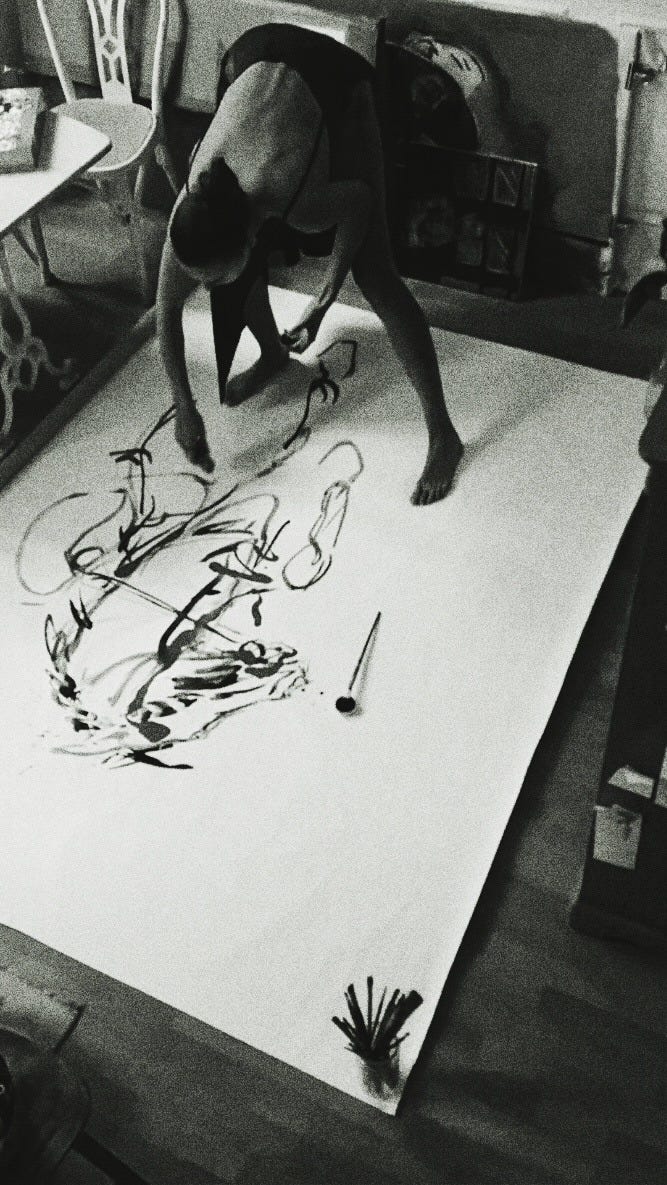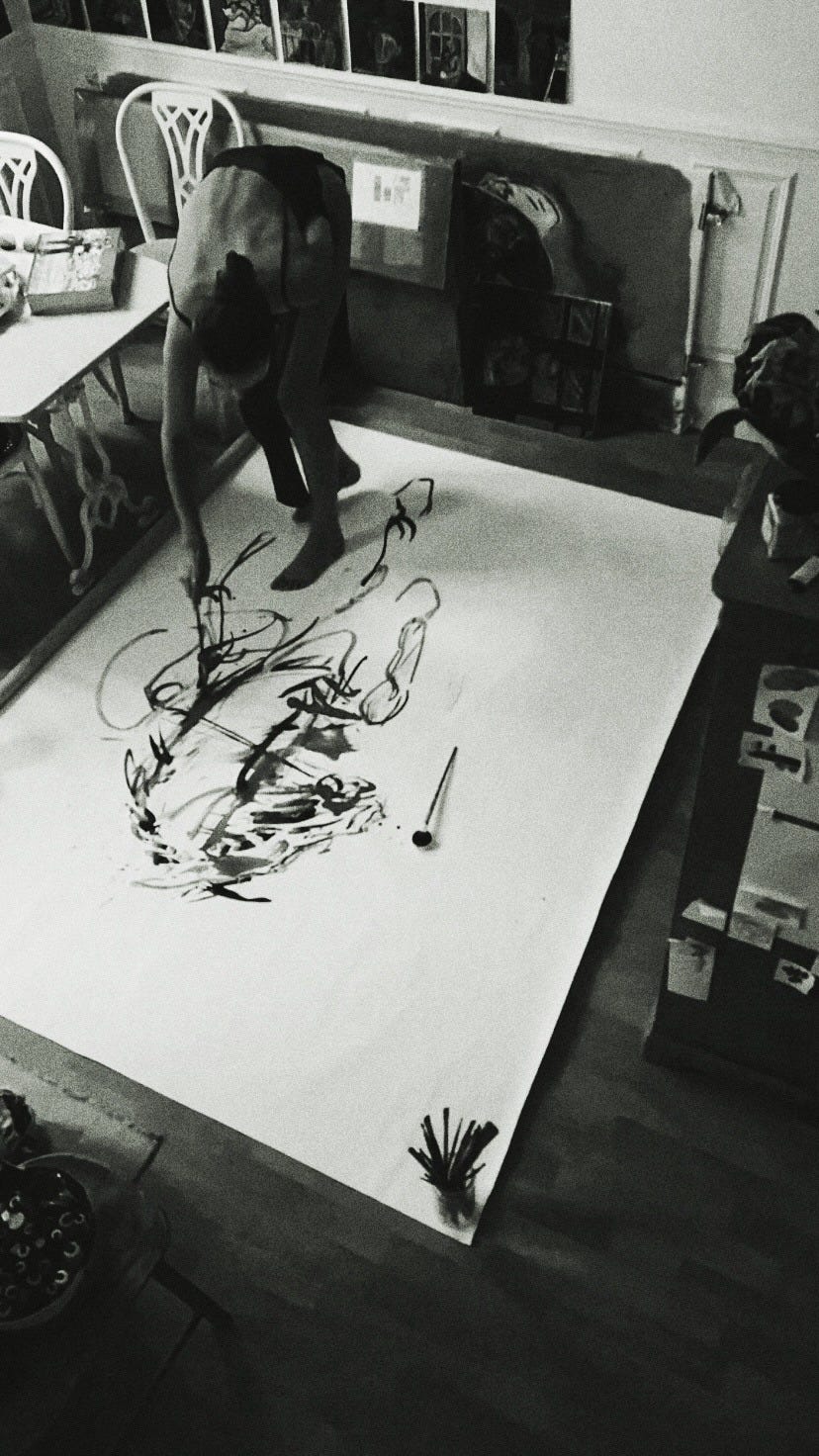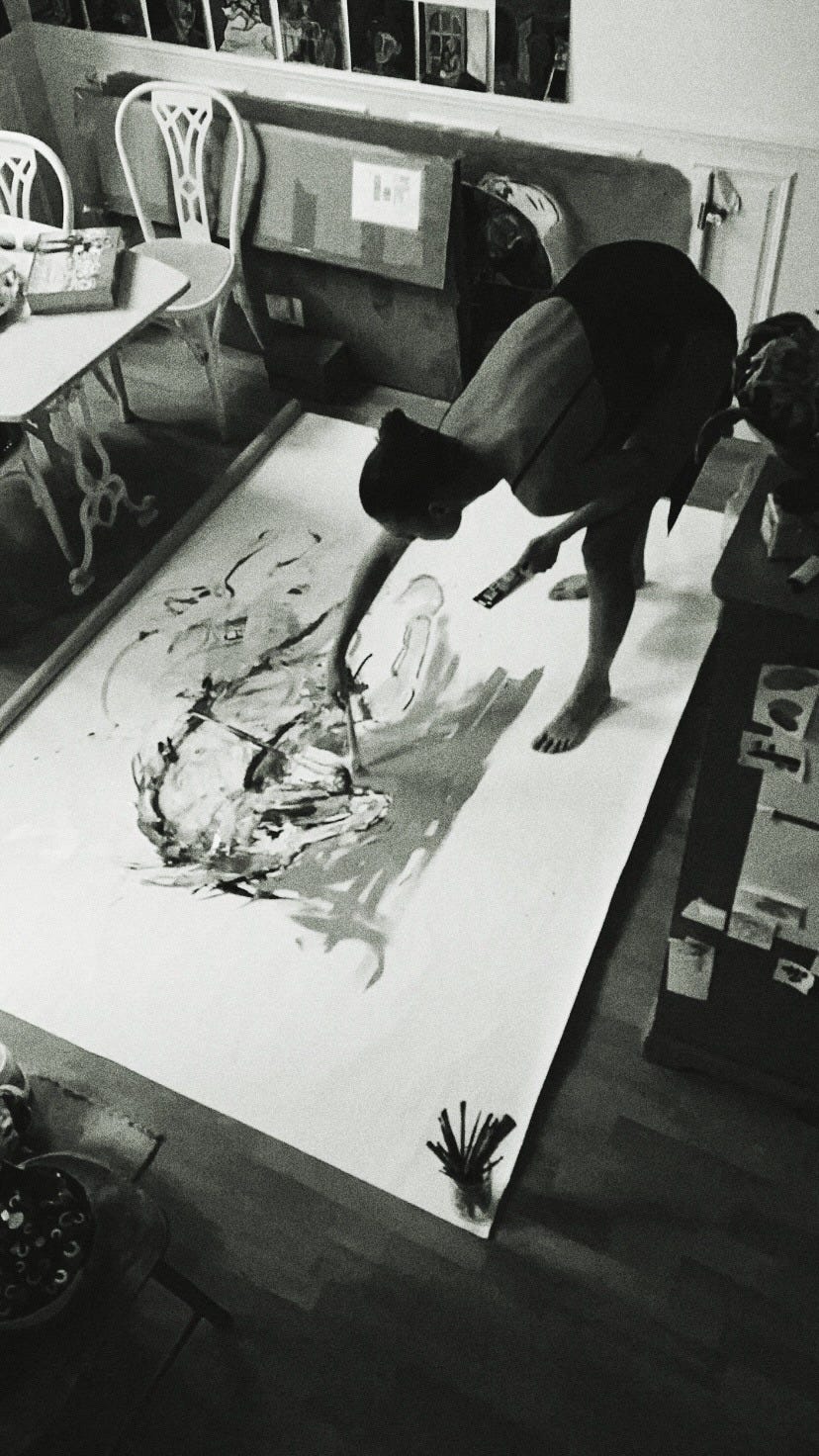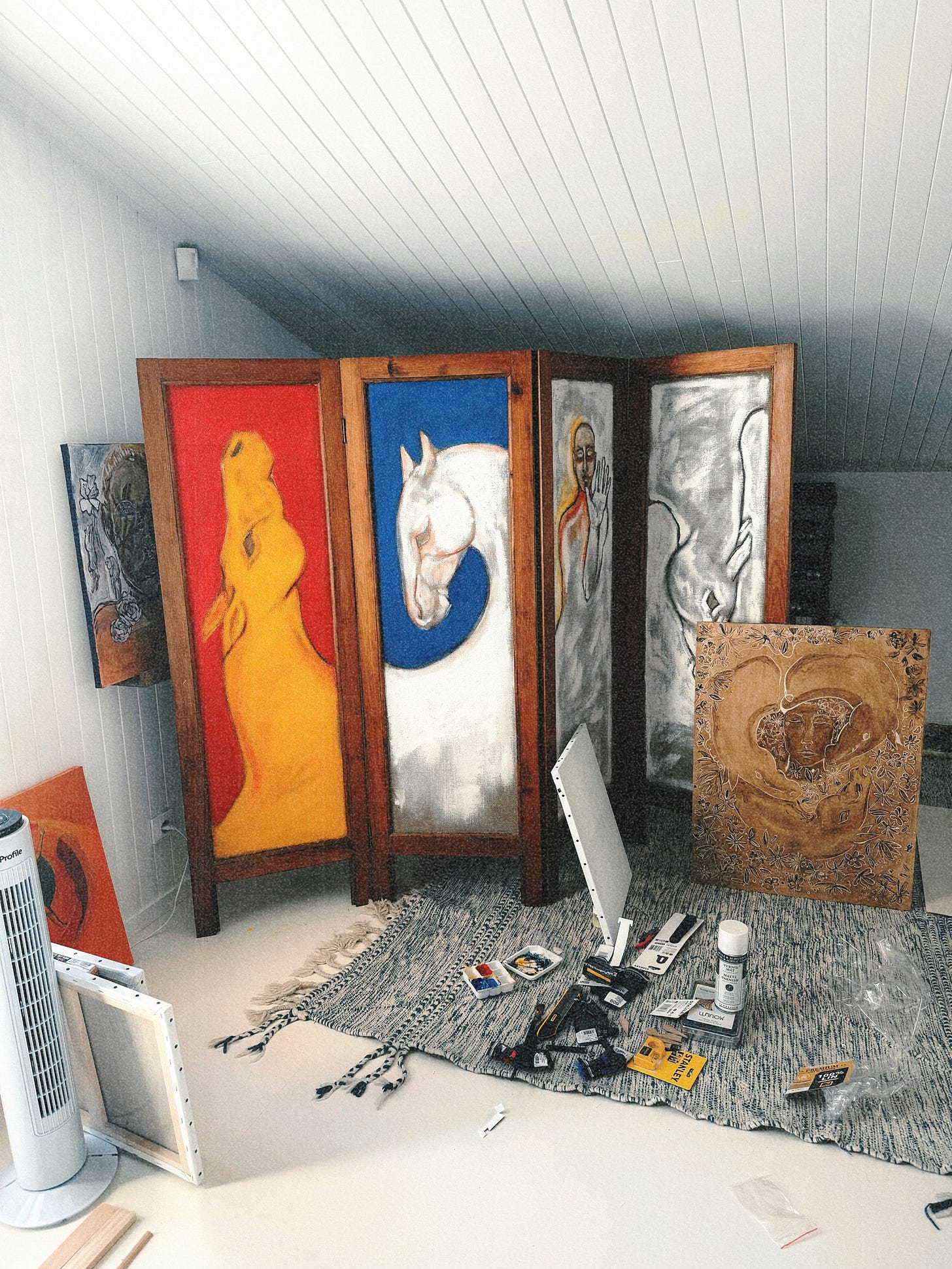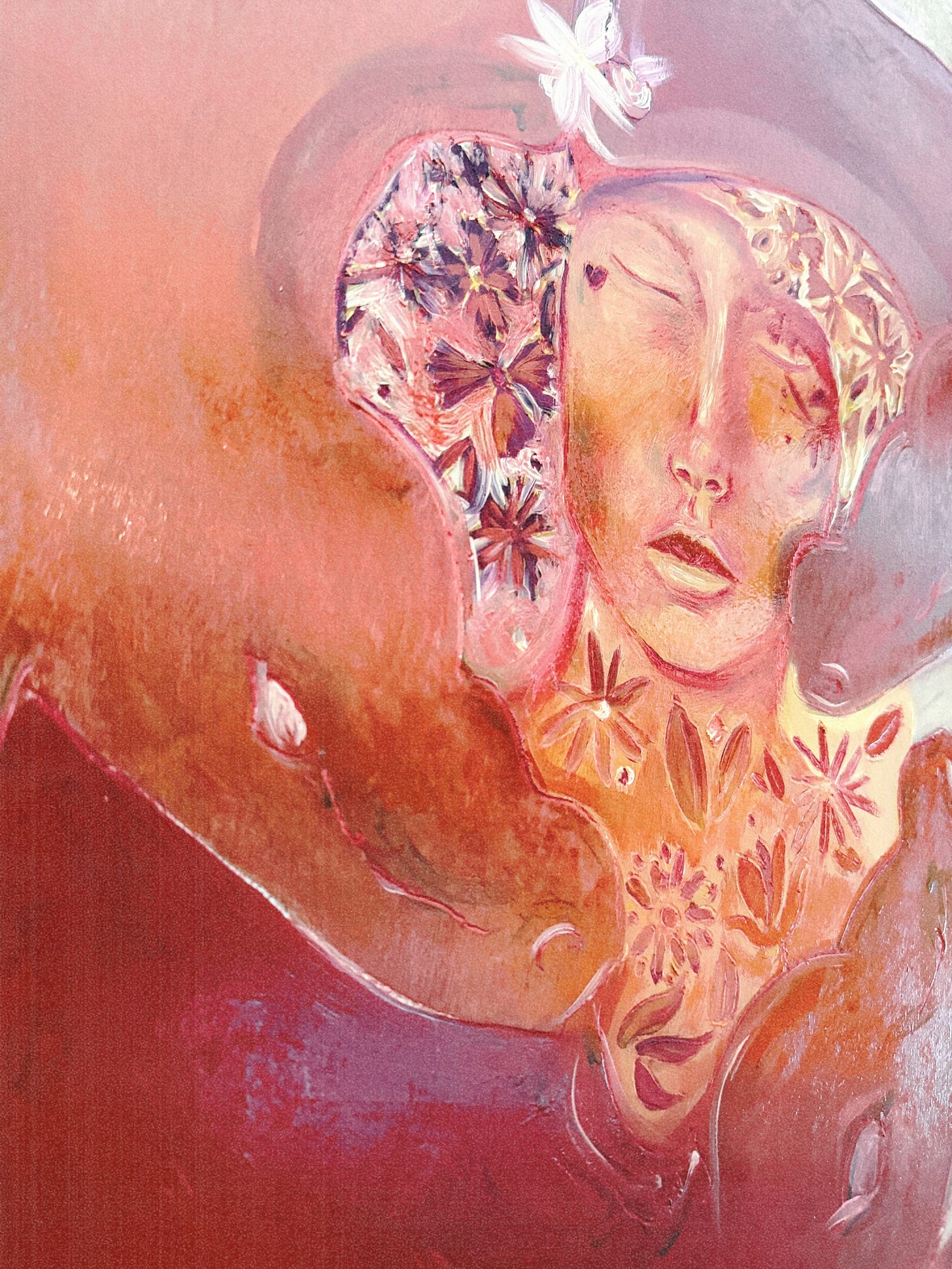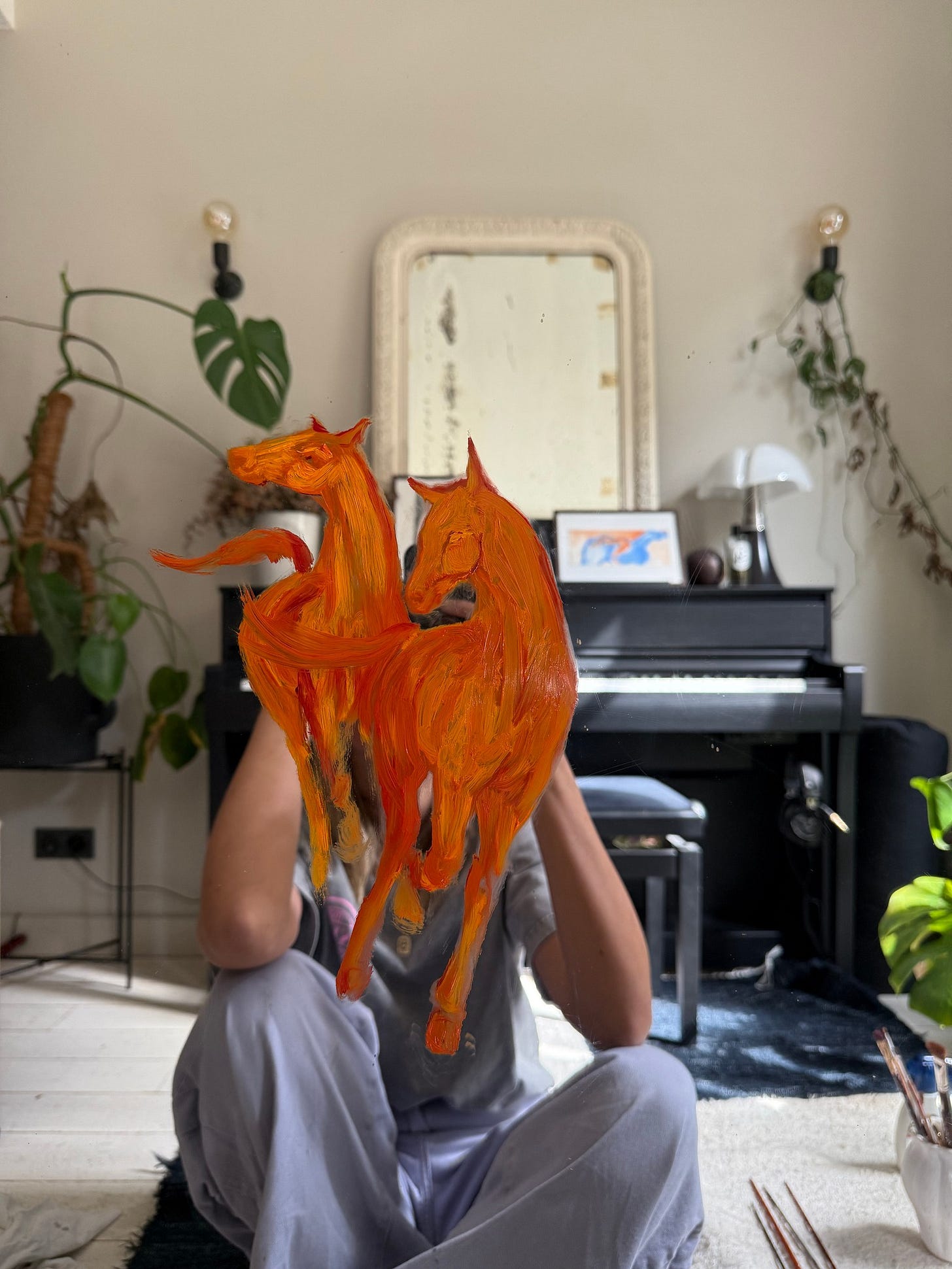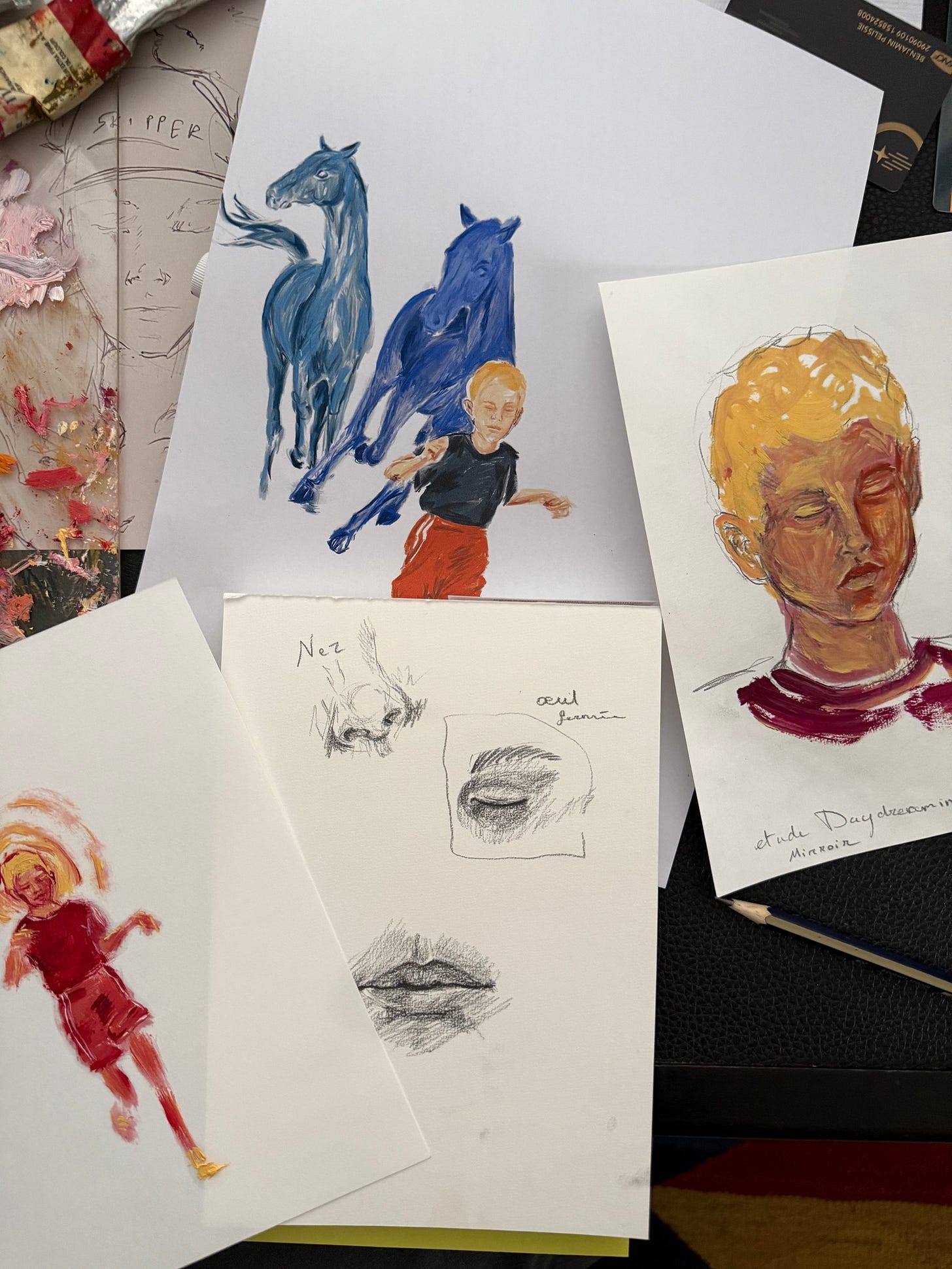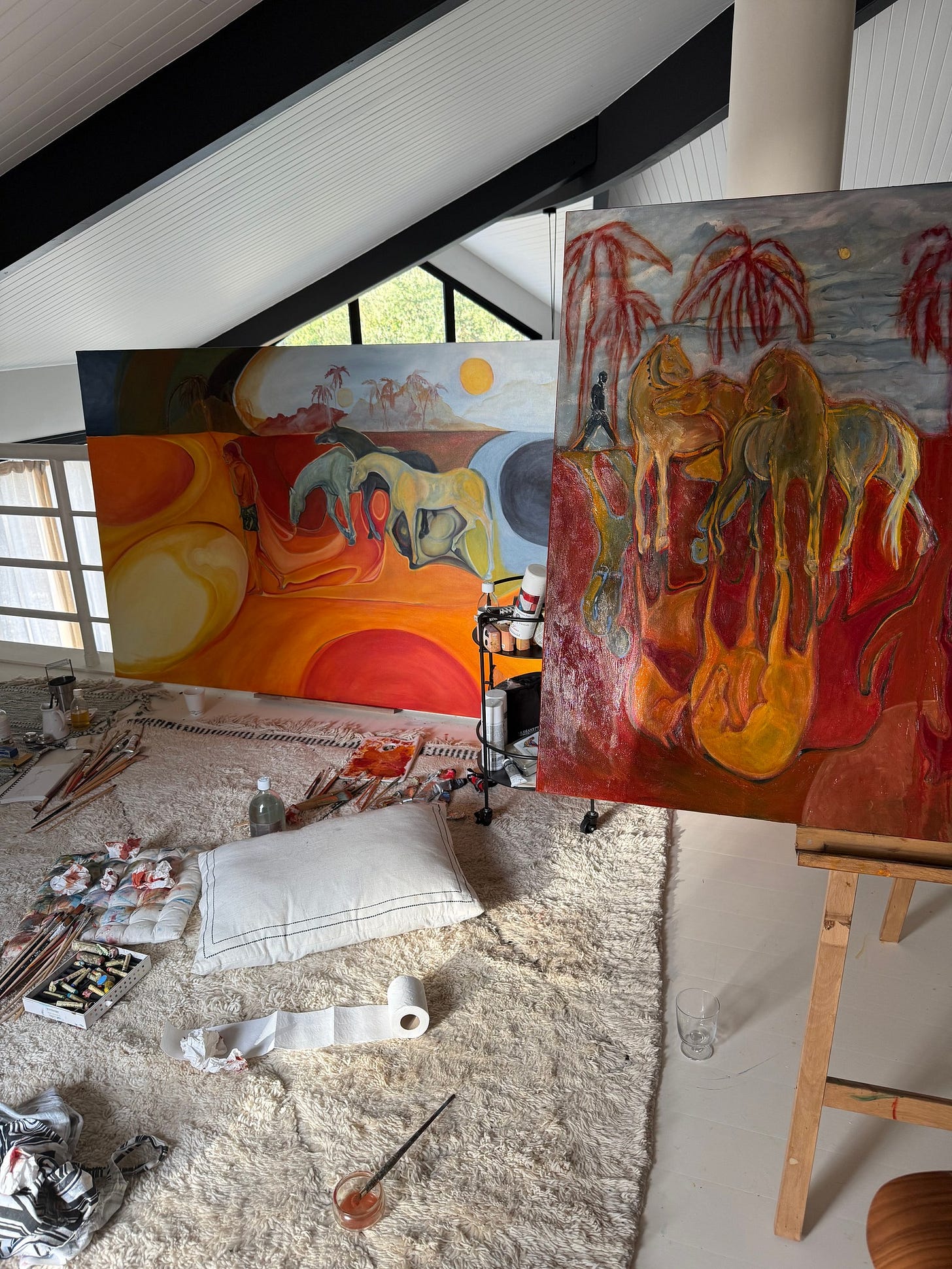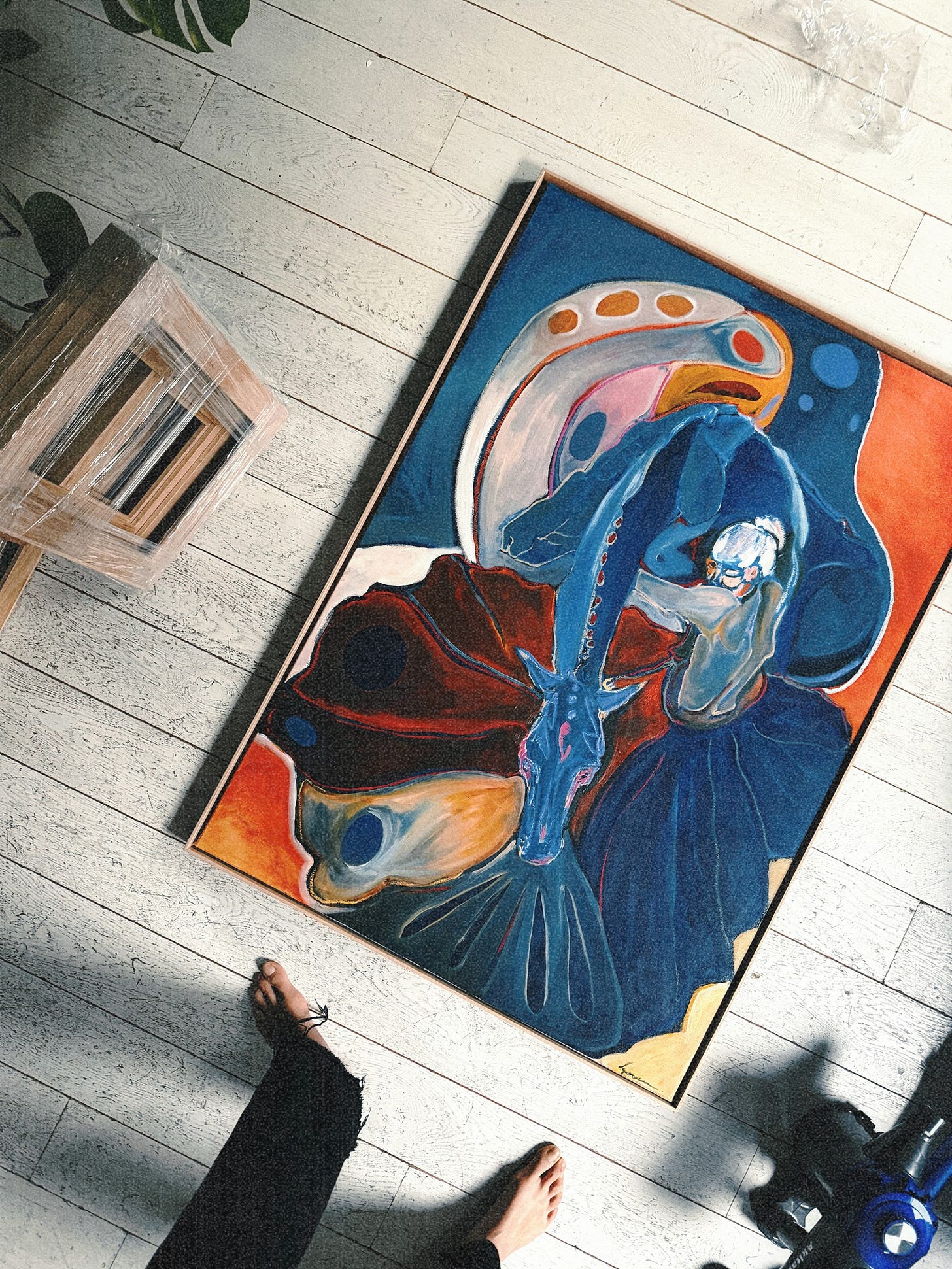In Conversation With: Isabel Deprince
"The horse is the language for me. That's the way I can talk."
Before Aurélie and I met, we’d been followers of Isabel’s story via her Instagram account. What drew us in was obviously her subject matter, but what made us obsessed was all her—as charming and effervescent as the horses she paints. Isabel’s paintings of horses are a far departure from those of history’s equine artists, drawing from the depths of her seemingly endless creativity, jumping and dancing with vivid colors and fluidity, inspiring a certain lightness just by looking at them.
We had the privilege of speaking with Isabel in her Paris home, shortly after she returned from her painting atelier outside the city. Our conversation, most of which comes below in edited form (for clarity and length), navigates her journey from being a horse-crazy young girl growing up in Antwerp, to traveling the world as a runway model, returning home to face tragedy, and finally, seeking solace in the animals she has always loved.
But before we start jump into the conversation, we promised to include a gif of Isabel’s alter ego, Spirit, by way of introduction—
“I'm telling you—this is Isabel! This is what goes through her head when she draws. When she paints. People are gonna think I'm crazy.”
Cece Liu: We’re honestly so excited to speak with you. Aurélie and I were thinking, okay, we should really do an interview series so that we can meet and speak with and connect with those that are doing really interesting things within art and design and horses. So we were both like Isabel! —and Aurélie was like, ok let me reach out. I'm like, reach out in French, I'm not able to do it [laughs].
ID: No I lived in New York for a bit and in London so French is actually my third language. Flemish is my mother language then English and then French. French because of my partner, I had to learn basically. The horse culture in like the Flemish side is really active, it's very very big.
CL: Going back to everything—you were a model I think I read for years and years?
ID: That's right, like New York for 12 years, for 12 years it's crazy. I actually did art school for five years in Antwerp and then I was 18 and finished. I then started university for arts and I was like, well, I've done it for four and a half years now but everyone that came, most of them haven’t done art school before.
So I arrived and they were explaining to me everything that I had already learned for for years and I was like, I'm not gonna do this again. I didn't tell my dad at first, I just left. I just didn’t go to classes anymore because my dad was already disappointed that I was doing arts.
So I stopped art, and I left to New York for modeling because I had been doing modeling since 14 to pay for art school. I just traveled the world, I was making money, I was going to amazing parties, I was seeing celebrities! It was great. And it was working really, really well. And that was like a bit at the height of my career.
And just one year before COVID, my brother got sick and he got cancer. And it was really a roller coaster. And for me, I wasn't very vocal and I didn't really know how to speak about my emotions. So I said, I'm going to start art again. I was already painting a little bit, but it was more for like fun and it was not really—I was just doing stuff.
And I really started doing a lot of art again because I was like, OK, this is how I can talk. And I was making a lot of very dark art about my brother. But this was what I was feeling. This was not my brother's personality, but this was how I was feeling. So I was trying to explain what I was feeling and trying to translate my emotions into my paintings. Just so I wouldn't keep it inside.
But then I lost my brother. And after that, I kept doing very dark art and all about him. And, you know, like it can help, but at one point it can start to pull you back down. So it started pulling me back down and I couldn't get out of a depression. I couldn't get out of being sad.
So I was trying to find new subjects. I started horse riding at six years and I always used to draw a head of a horse for my grandmother. And I don't remember that [laughs]. And she was like, I'm so happy you're doing horse art now because you used to draw horses for me all the time.
CL: Oh, my gosh. Did she keep any of your old drawings?
ID: My mom brought them. My mom brought them recently to our house in Cap-Ferret, and she brought this big map with like all my horse drawings of when I was little.
Aurèlie Colliot: So that's why you think that you focused on a horse rather than, I don't know, a cat or a dog or maybe on birds, you know?
ID: I mean, I had animals my whole life. I grew up like a farm style life with my grandparents a lot. They had like all sort of birds. I had a rabbit, I had dogs, I had animals my whole life. But I remember I didn't have money for a horse, so we rented a horse. And I would go like three to four times a week and it would be an hour on the bus because my dad didn't have time to bring me. So I would go after school one hour on the bus all alone, see the horse to go ride and then come back. It would be my safe place.
So every time I was feeling bad, sad or was hard at home because our home situation was not easy, I would flee into the stable. I would cuddle with the horse. And I remember one time the owner, she had to sell the horse and I cried. It felt like someone died.
It was awful. I cried so much and I felt super safe there. And I felt like they could listen to what I couldn't like say.
So I started with drawing dancers and I like movement. And then I started drawing horses and my first horse, I mean, I was sold. I couldn't like do anything else than horses after.
“And everyone always told me, why are you, when are you going to change the subject? Like it's cute, the horses, but like it's a lot of horse [laughs]. I was like, I don't know, you get it? I don't think you didn't get it. I don't think you got it. No. It's not going to change.”
CL: I totally get it. I live in Los Angeles and I'm friends with a lot of artists here and I know a couple people whose subject matter is the horse, but of course you explore different themes. I think what sometimes people don't understand is like, it's not just about drawing the horse. It's about exploring like the themes of what it means to like have the relationship with the horse or what the horse is capable of conveying that maybe you're not able to convey. And it's such a deep, deep subject matter.
ID: I think so too. I always felt like art around horses is very traditional still. And when you say like, I paint horses, people look at you like—
CL: —you're from the 1600s!
AC: Yeah, exactly what we understood, because all the imagery of all the horses for the 21st century is too classic. And people always think I'm doing a horse. And they always think that you're doing all the physical format and all the correct elements and measurements. And they don't realize that you can give more emotion through a horse without a specific image of a horse. And it's totally our 21st century image.
ID: I really want to modernize the world of, like the horse world around art. It's still not really very modern. I mean, and there's such a client. There's so many people that love their horse and they love modern things as well. I mean, we've done all on this classic horse painting that you go in a book and you see like in every book. You want to have what you feel, the movement, the expression. The thing that is joy.
I'm always shocked by how these horses all look like terrified. They look terrified and not happy. Their eyes are huge! And always in the mouth, it’s all ripped open. I'm like, what is this? I wanted to change that. For me, horses are a language, absolutely. So I really tried to talk through the horse with my art and not just, okay, I’m drawing a horse. No, I'm trying to tell a story and I cannot speak it correctly so I use the horse to tell it for me. And that's really my motivation to do all the talking by the horse and the painting.
CL: Do you think there's a certain aspect of the horse that, when you found it, you were like, aha, this is it.
ID: I think it's really because it's such a big animal, but so calm. They are frisky and everything, but they have an energy that is so calming and so nourishing. And just drawing that and connecting to that energy, that calmed me inside as well. And I started, I literally started going to more fluid lines, more colors, and the horse guides me. I just drew the horse and it came after. I felt that this was the way to heal myself.
I really believe in happy art and happy thoughts and things that speak again, like not decoration. I want to change something with a subject that has to be changed as well. I started with the horse and then the horse brought me to a good place, and now I want todo a bit honor to that. Now I want to show it to the world that actually any passion that you can have, anything that makes you feel happy can make you like get over any situation. So it's really the message that I want to say to people that like, it doesn't need to be a horse.
The horse is the language for me. That's the way I can talk. But for anyone, it can be something else. And I really want to show that if you love something and if you feel energy and you feel being healed by something, use it. And that is what the horse did for me. But I mean, for anyone, it could be something else.
AC: But it's interesting because also, even if you are saying that, you have chosen the horse to speak, but you don't want to choose a kind of rude words in a way. I mean, you are taking care about how the horse is in the painting. We spoke a few minutes about the eyes and about the mouth. And you don't want also to make a terrifying horse. So even if you are collaborating for humans, you don't want the horse to have like a rude image. So it's good for you and good for you to consider the image of the horse. I don't know if I'm totally clear, but...
ID: No, it makes sense. No, I totally get it. Like it's for me very important that, like, I mean, I never was scared of horses. Although like they are huge. When I was like six, I was already like trying to climb on the biggest one in the stable. And they were like... !!! And I was like, no, it's okay. I mean, I would like chase between their legs. I would do crazy, stupid things, but I was not one day scared of the horse. And I knew like they wouldn't... First of all, they wouldn't do it on purpose. If they would do something, it would be by an accident. Like we would fall riding a bike. Like, oops, like it can happen, there is a stone and you fall. But I always felt super safe.
It's the same like now with my brother. I'm starting to portray my brother in my art for my first series. And I didn't want to paint him because I didn't feel happy and joyful yet. And I was scared that I would portray my brother in the wrong way. I was scared to draw him and paint him in a sad and depressive way, because his energy and his personality was very joyful. So I waited until now because I wasn't in the right place to portray him in the right way because that was how I was feeling, but that was not who he was. And it's the same for the horses, I think. If I would feel sad, the horse would not look happy. So for me, it shows and I really... If I'm having a bad day, I don't work. I don't paint because it would show. I'm very sensitive.
CL: It reminds me of also the relationship because horses are so sensitive, right? Like I think I was reading something, a study recently that talked about how if you're having an anxious moment and your heartbeat is elevated and you're on a horse or you're beside a horse, their heartbeat actually elevates to your level and it helps to bring yours down. And that's why you feel the calming feeling of being in the presence of a horse. And like everything that you're saying in terms of your own process with painting is so reminiscent of like, not that you are a horse, but the sensitivity, you know?
But, you know, even speaking with you, I think you exude a certain like joyfulness that it's not hard to imagine that you found horses as like your way to communicate things that you're feeling but not necessarily able to say and kind of the way that you're able to do it also with horses.
ID: Yeah. Exactly. It's magical. I mean, and the thing is like, as I'm working so much, I cannot be around horses as much as I would love to. I don't even have time to ride. I wanted to take like a demi-pension, like a half stable, but I didn't have time. And I was like, it's not fair to not go enough. And so now like the only horses that I'm connected with is my art. And because I don't have time to go to the stables. In Paris, you have to go far. It's half a day worth. And I'm already, I don't have time to cook for my partner. So I'm like, how am I going to go and ride? So for me, like, this is the easiest way to be with them all day because I'm surrounded by horses all the time. And I feel their energy really in the paintings. And I hope one day that I can buy my farm with my horses. It's the goal.
AC: Yeah, absolutely. It's the goal. Absolutely.
CL: Everybody here wants to have their farm with the horses and create. I was actually just going to ask if you had, you know, horses in your life right now. When was the last time you kind of rode consistently?
ID: I mean, consistently was before I had to give up horse riding for my art school. I was 16. Now I go like every vacation I go and ride. Find horses, yeah. I was like on a ski vacation and there were like ponies for kids. I was standing there with my snowboard and I was like around the pony and the guy was like, they're for the kids. I say, that's okay. That's okay, I'm just hugging him! I was with all these like girls and they were like, what is she doing? Is she actually hugging the pony? It's how you figure out who's the horse girl and everything [laughs[].
But now I think like I'm doing like one of my biggest exhibitions now that I'm preparing since like months. And I think after that, I really want to go like on a horse travel and I want to go like two weeks. I really want to do Patagonia. I really want to do it. To Patagonia on a horse, trekking, sleeping under the stars on the ground. Yes. So perfect.
CL: Do you want to do a special artwork related to that?
ID: Yeah. I mean, I'm sure I'm going to take notes and paint it. But I mean, I don't plan. I really don't plan. At the moment I'm working on this series of my brother daydreaming and it's all I'm working around and all I'm doing. And I really want like something like 40 paintings. I have like five ready. It's for June.
CL: Wow. Okay!
ID: But I'm like working a lot and like sometimes it comes and flows and then after that I'm going to be empty. Like because you did everything out. It's very intense. Yeah. So I don't know what I'm going to do after. And I don't know how the exhibition is going to go. And then I don't know what I'm going to do after. And then sometimes I need like months to find like the inspiration. So I think I will leave then like on a horse or whatever.
CL: You don't plan?
ID: No. I don't plan anything. I mean I plan exhibitions and I organize everything myself. I don't work with galleries. Yeah. And this is because of my modeling. It's because of modeling. I worked so long under the head of an agency, am I really going to like get my freedom doing what I want finally in life? Again as an artist somebody says like what I can do and what I cannot do. And take a percentage on top. I was like no. So now I have my collectors. I have like a very big network already through modeling, and I just started doing like these exhibitions in pop-ups and in apartments and in houses. And people really love it and it works.
My dream is to become the biggest name in art with horses. I dream big or I go home. 100%. There's no comparison. But the thing is that I really want to try to put horses everywhere. I do a lot of collaborations already and I'm trying to work as much as possible, but sometimes it's very hard to open people's minds because they're like, yeah, but a horse doesn't match. I'm like, well, I mean, that depends on how you see it. I was invited to this hotel in Courchevel and they asked me to do something with the hotel and I said like, yeah, I can do it, but I have to have horses in it. So I drew these horses on all the pictures that I took there and like everyone was like, this is insane. Like it worked super well. Because it's like a hotel for skiing, and they were like, there's no horses inside. Well, it's fantasy. You can have it with anything.
CL: Oh, right. Well, this was amazing, Isabel!
ID: Yay! It was so wonderful. I'm really happy to meet you guys like this. It's really fun. And... I feel like we're all on the same page. It's really fun.
CL: Yeah. A hundred percent. And I'm sure you've been finding this since you've been working on your art in this way. But I think that has been probably the happiest surprise that I've gotten, like since I've launched the brand is just the... Like it's not just you're a horse person. It's also the depth of understanding it and being able to interpret it in an artistic way. I think that's kind of the connection point. It’s been my favorite part.
ID: Yeah. I've met a lot of people in the horse world now. It's not just like let's make money. It's like they're really passionate. So everyone I meet is so nice and like so chill. And so like, oh yeah, I love it. Let's do something. They're just like really cool people.
CL: I think this is the other side of doing everything yourself too, because if you go through a gallery, like you oftentimes have no idea who your collectors are, unless they reach out to you specifically. And now you're able to create these really beautiful memories with them. Like, it's not just that they have a piece of your work, they have this memory of you hanging out with them all day in the stable, meeting their horses or sitting down to dinner, like they know you as a person. And that makes the work really stand out.
ID: It's super important for me. Like all my collectors, I'm super close to them.
I have one in Paris that is a Picasso collector. It's one of my first collectors, and I'm so close with him. And we go for dinner, we go for drinks, I'm like best friends with his accountant. I meet her for drinks without him and she's like, I don't know how you do it. I'm juggling everyone at work. I do all my art. I do all the, I do my own website, I do everything. I do my own social, I do like all my meetings. I meet with my collectors. And she's like, when do you breathe? I'm like, but this makes me breathe. It's fun for me. It's fun.
So I mean, it's not work, but it's fun. Yeah, totally agree. It's a lot of work. I love it. So it's not hard, like when you love something. And it's very special. It's like having been able to like find this thing, because they think it's kind of like, oh, there is that saying, if you do something you love, it's not work. But it's so elusive. Like, I think it's so difficult for, you know, to actually achieve that.
[Isabel’s dachshund scurries into the room].
Oh my god. Come here. Sorry. Hello. I have animals. I have a lot of animals. I have a cat, I have dog. I don't have my horse yet.
AC: You will! That’s the next goal.
ID: I always said that my biggest painting, that I would sell for a lot, a lot of money, I want to buy a horse with it and call it the same name as the painting.
CL: Yes, yes absolutely! Put it out there, manifest it. It will happen.
You can find Isabel on Instagram and a selection of her work on her website.


